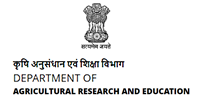Livestock Management
It may be due to:
- Improper care during kidding
- Unhygienic housing management
- Pneumonia
- Cold and wet housing conditions
Remedies:
- Protect cold wind by covering a coarse cloth on body
- Put coarse cloth/gunny bag on the floor as bedding material
- Plant wind brokers
- Expose it to sun light
- Of a jersey cow average milk production is = 2.5 litres / day
- Of a desi cow average milk production is = 14 litres / day
- Supply 30kg of green fodder per adult animal
- Feed 2kg of concentrate per day as pregnancy ration during last 75 days of pregnancy
- Add mineral mixture to the ration of the dairy cattle
- Provide balanced ration to the animal
- Vaccinate the animal regularly against diseases
- Stop milking of animal 60 days before expected date of calving
- See that your cow should conceive within 3-4 months of calving
- Crossbred cows should preferably be bred with semen of the crossbred bulls of same exotic blood levels
- Get the desi cow inseminated with semen of bulls of exotic breeds like jersey
- Be present during calving
- In case of any complication, take the help of Vet. Officer
- After delivery let the cow to lick the mucous of the calf’s body or remove with a clean cloth
- Check the respiration of the calf by removing mucous from nostril / help artificial respiration
- Allow the calf to stand and suck the colostrums within 1 to 2 hours of birth
- Throw the placenta and mucous far away from the cow or burry it under the earth
- Do not allow the cow to eat placenta as it decreases the milk production
- Green legumes : 10kg
- Green cereals : 20kg
- Cereal straws : 2kg or
- Cereal straw : 7kg
- Concentrate mix : 3.5kg
- In addition to this the cow may be given green fodder as per availability in the area.
- The cross bred cows produced from indigenous breed +jersey/Holstein Friesean bulls give more milk than local breeds.
- A normal local breed yield 500kg of milk in an average lactation period of 268 days.
- A cross bred cow of jersey and Holstein Friesean yields nearly 3000 to 4000 kg of milk in a lactation period of 305 days.
- In case of ill health, the cow yields less milk
- The milk yielding capacity increases for 1st 2 to 3 years and then declines with age
- With the advancement of lactating period upto dry the yield decreases
- If the cow is not cared properly during dry period the milk decreases 30 - 40%
- If milking interval is less, then milk yield decreases
- In case of high or low temperature, the cow remains under stress and it affects milk yield
- Should be kept in comfortable well ventilated cleaned and disinfectant shed
- Ceiling fan and exhausted fan should be provided in summer months as they have less heat tolerance capacity
- Cold water should be sprinkled over the cows during hot days
- They should be fed with balanced ration
- Adequate green fodder and roughage should be provided
- Vaccination should be done in regular intervals
- Clean the animal shed and bed
- Disinfect the shed with soda washing
- Avoid over crowding
- Heavily parasitized animal should be segregated and periodically treated with dewormer
- Practice the rotational grazing
| Sl. No. | Diseases | Prevention |
|---|---|---|
| 1 | FMD | FMD vaccine 6-8 weeks of age, 10ml S/C Booster dose at 6, 9, 12 months and annual dose. |
| 2 | Rinder pest | Rinder pest freeze dried goat tissue vaccine, all ages 1ml S/C every year preferably in winter months. |
| 3 | Anthrax | Anthrax spore vaccine at all ages 1ml S/C Booster dose in 6 months, annual, preferably in Feb/March/ April/May. |
| 4 | Black Quarter | Polyvalent BQ vaccine in all ages 5ml S/C Booster 6 monthly annually. |
| 5 | Haemorrhagic Septicaemia | HS adjuvant vaccine in all ages, 3ml S/C Booster 6 months/annual interval preferably in May/June. |
The vaccinations for different diseases of goats are mentioned below.
- FMD: Segregation and authorized sanitary measures, vaccination in Feb/March with polyvalent FMD vaccine 2-3 ml S/C.
- HS: Segregation and use of sulphonamides and antibiotics like penicillin, vaccinate the animal with 0.5 to 1ml S/C animal H. S serum vaccine.
- R. P: Vaccinate the animal with tissue culture vaccine 1 ml S/C in neck region, revaccinate after 3 years.
- Goat Pox: Vaccinate the animal with pox vaccine @0.5 ml S/C.
- Vaccination
- Segregation of sick animals and change of pasture
- Disinfection of shed and proper disposal of litter material
- Affected animals should be slaughtered, burnt or buried 6 feet deep with lime
- Use of antiserum in affected animal
- Quarantine
- Use of foot bath
- Timely treatment and visit to goat shed
- Report to district livestock authority
- Personal hygiene and authorized sanitation
All the male kids (goats) must be castrated by Burdizoo’s castrator at an age of 2 to 4 weeks and 4 to 6 months in case of calf.
- Before 15 days of arrival of chicks clean and disinfect the shed
- Arrange light in the poultry house and brooder
- Do brooding of chicks to provide artificial warmth
- Maintain temperature upto 90-95 degree F
- Keep 24 hours lighting system with 2 watt / chick
- Make availability of 0.5sq. ft. floor space / bird
- Brooders are to be fed with chick starter mash from 0-8 weeks of age in case of layer and 0-3 weeks in case of broilers
- Poor quality of the feed
- Poor quality of the stock
- Improper feeding and lighting programme
- Over crowding
- Environmental stress
- Improper vaccination
- Lack of technical knowledge of the rearer
- Land should be sufficiently elevated
- Should not be too far from the city
- It should have transportation facility
- North-South shed should have wire nettled mesh
- East-West shed should have complete wall
- Width of the shed should be between 16-24 ft.
- Height of the walls should not be more than 1 ft. above the floor level
- Roof should be made up of asbestos
- The overhang of the roof at every shed be 3-4.5 ft.
- Litter shed be practically dry
- After 2 weeks the litter is to be raked every day morning
- Keep water and feeder away while raking
- Ventilation should be proper in house
- Never try to recycle the old litter for subsequent battlers
- Periodical testing of layer flock
- Fumigation of incubations and equipment
- Mixing of Neptin powder at the rate of 1000 gms in 1 ton of feed
- Proper hygienic measures
- Make arrangement of proper vaccination at 8-10 weeks of age
- Maintain proper ventilation and hygienic condition at the farm
- Proper vaccination of the birds
- Provide toxin free feed to the birds
- Routine screening of sire samples in large farms
- One species of birds should be kept away from other species of birds
- Flock should always be started with disease free day old chicks
- Care should be taken for handling and disposing sick or dead birds
- Proper brooding, feeding and water management should be followed
- Vaccination should be carried in a regular manner
- Avoid entrance of the visitors
The egg laying potentiality of an improved layer varies from 280-300 eggs per year.
The rabbits are mainly forage eaters which consist of tender grasses, fruits and nuts with less crude fibre. Rabbits prefer concentrated pallated feed to mash feed.
The age of marketing ranges from 10-20 weeks at which the rabbits attains a body weight of 1.5 to 1.8 kg.
The dressing percentage ranges from 45-55% in animals of higher body weight. The net profit in first year is around Rs 2,500/-, in second year is Rs 16, 000/- and in third year Rs 21,000/- if we keep 50 numbers of female rabbit with 10 male rabbits.
- Back to previous page
- |
-
Page last updated date:17-04-2024 07:21 PM
 भारत सरकार | Government of India
भारत सरकार | Government of India











